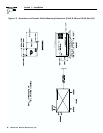
1.3 BEFORE INSTALLATION
Before installing this equipment, check the ratings of both
the generator and the transfer switch. Read “Emergency
Circuit Isolation Method” and “Total Circuit Isolation
Method” in Sections 1.8 and 1.9 (Page 11) carefully.
The generator's rated wattage/amperage capacity
must be adequate to handle all electrical loads that
the unit will power. You may have to group the criti-
cal (essential) electrical loads together and wire them
into a separate emergency distribution panel.
NOTE:
In some areas, you may need to acquire electrical
permits for installing an emergency system, build-
ing permits for installing gas lines, and permits for
noise allowances. Check your local codes before
installing the unit.
1.4 LIFTING THE GENERATOR
To lift a nonsound attenuated generator, insert pipe
having sufficient strength and diameter through the lift-
ing holes (lifting brackets are provided with sound
attenuated units), which are located near the unit’s base
(see Figure 1.1). You also may lift the unit using a hook
and hoist method provided you use a spreader bar to
ensure that the lines clear the roof.
Figure 1.1 – Location of Lifting Holes/Brackets
When lifting or hoisting equipment is used, be
careful not to touch overhead power lines.
The generator’s weight of more than 300
pounds requires proper tools and equipment,
and qualified personnel to be used in all phases
of handling and unpacking.
Exercise caution when lifting the unit
manually as it may shift on lifting pipes during
transportation, which may result in injury.
The generator was not designed to be lifted by
its roof. Use the lifting holes or brackets provided
near the base of the unit. If using a hook and
hoist lifting method, you must employ a spreader
bar to prevent from crushing the roof.
1.5 ENGINE OIL RECOMMENDATIONS
Use oil of American Petroleum Institute (API) Service
Class SG, SH or SJ. Select the viscosity based on the
air temperature at the time of operation. See the fol-
lowing chart:
*Organic break-in oil is required before using synthetic oil.
Any attempt to crank or start the engine before
it has been properly serviced with the recom-
mended oil may result in an engine failure.
1.6 GASEOUS FUEL SYSTEM
NOTE:
The following information pertaining to gaseous
fuel systems is provided to assist gaseous fuel
technicians in planning installations. In no way
should this information be interpreted to conflict
with applicable fuel gas codes. Consult with your
local fuel supplier or fire marshall if questions or
problems arise.
1.6.1 FUEL SYSTEM REQUIREMENTS
AND RECOMMENDATIONS
When installing the fuel system, install a flexible
length of line between the generator fuel connec-
tion and the rigid piping. The flexible hose must
be approved for use with gaseous fuels. It is rec-
ommended that an emergency manual fuel shutoff
valve be placed in-line.
◆
LIFTING BRACKET
Section 1 — Installation
Guardian Air-cooled Generators
Generac
®
Power Systems, Inc. 5
Temperature Oil Grade (Recommended)
Above -7º C (20º F) SAE 10W-30 or SAE 30
Below -7º C (20º F) SAE 5W-20 or 5W-30
All Seasons SAE 5W-30 Synthetic*
(6 kW, 8 kW and 10 kW)
(Sound Attenuated)


















